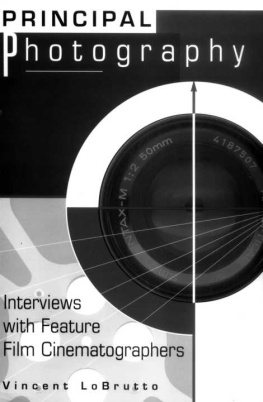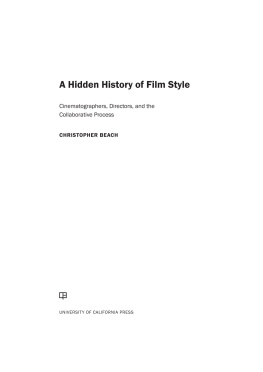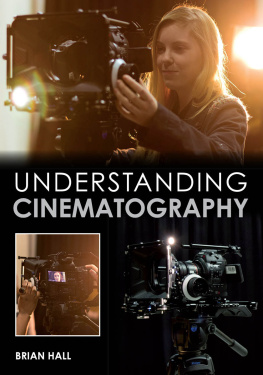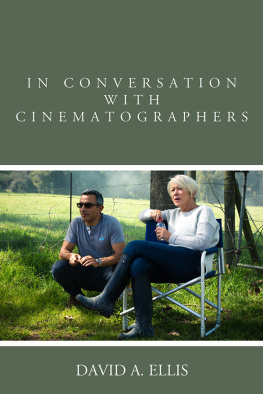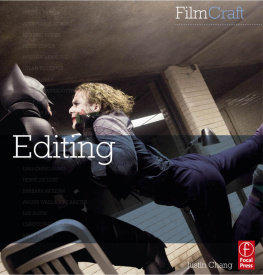
Film Craft

Cinematography
Mike Goodridge & Tim Grierson
ILEX
First published in the UK in 2012 by
ILEX
210 High Street
Lewes
East Sussex BN7 2NS
www.ilex-press.com
Copyright 2012 The Ilex Press Limited
Publisher: Alastair Campbell
Creative Director: Peter Bridgewater
Associate Publisher: Adam Juniper
Managing Editors: Natalia Price-Cabrera & Zara Larcombe
Editor: Tara Gallagher
Art Director: James Hollywell
In-house Designer: Kate Haynes
Designer: Grade Design
Picture Manager: Katie Greenwood
Digital Assistant: Emily Owen
Any copy of this book issued by the publisher is sold subject to the condition that it shall not by way of trade or otherwise be lent, resold, hired out or otherwise circulated without the publishers prior consent in any form of binding or cover other than that in which it is published and without a similar condition including these words being imposed on a subsequent purchaser.
Digital ISBN: 978-1-908150-69-1
All rights reserved. No part of this publication may be reproduced or used in any form, or by any means graphic, electronic or mechanical, including photocopying, recording or information storage-and-retrieval systems without the prior permission of the publisher.
Special thanks to Caroline Bailey, Dave Kent, Darren Thomas, Phil Moad and Cheryl Thomas at The Kobal Collection, for all of their effort and support.
Every effort has been made to acknowledge pictures. However, the publisher apologises if there are any unintentional omissions.


Table of Contents
Introduction
The peculiar alchemy that makes up a great film is rarely achievedlittle wonder, considering the demands on the team of people who must come together to support a common vision. It starts with the screenplay and over time crystallizes into another form through the efforts of the producer and director, actors, production and costume designers, cinematographer, editor, composer, and scores of others in each department. And, film being the most expensive art form to realize, the team is working under pressures of time and finance that can often harmalthough sometimes enhancethe finished work.
There is no formula for making a film. Like a building, it is constructed from the ground up each time, using the basic blueprint of script and director. Knowledge and experience are key, but beyond that a film requires that special, indefinable vision that all great artists possess. For that reason, the FilmCraft project can never be a simple how to guide to the crafts; each subject will illustrate his or her process, but what makes them unique cannot be learned or replicated.
The cinematographeror director of photographyis often the key conduit for all the other craftspeople on a film set. Through the cinematographers lens, all performance, direction, and design must pass, and the cinematographers own choices in cameras, lighting, and movement can inform and further the story in both obvious and subtle ways.
In the early days of cinema, the director also operated the camera; lighting was provided by direct sunlight or sunlight diffused by the glass ceilings of early studios. But by the turn of the century, as filmmaking became more sophisticated and films began to consist of multiple shots and locations, a breed of specialist camera operators emerged. Artificial lighting on sound stages was added to the mix, beginning an era of creative lighting that could change the mood and look of a film entirely. The use of different lenses, the introduction of color, and ongoing technical innovations throughout the twentieth century gave rise to an explosion of creative solutions and interpretations on the part of filmmakers who repeatedly defied convention to establish particular looks and moods.
The cinematographer is no longer merely the camera operator, but leads a team of people that often includes an operator, a focus puller, loader, grip and gaffer (). The best cinematographers take the job of being a leader very seriously. As a Director of Photography, I direct everything that has to do with photography, Eternal Sunshine of the Spotless Mind DP Ellen Kuras says. Yet, I dont simply see myself as a cinematographer. Im very embracing and caring of the crew and everything that goes on around me. That means the art department, the wardrobe, everything. Those people are under my wing, and Im gonna take care of them. Its my responsibility.
Working with the director, the cinematographer establishes the composition of a scene, the way it is lit, the movement of the camera in relation to the actors or location, and can often have a say, alongside the director and designers, on which colors should be used. Not all directors are visual, cinematographer Ed Lachman told us. So you have to find your footing with the director for how you create that language, because for me the language of cinema is images. The images are the subtext for the psychological world that you create for the characters.
Budget levels are another factor. Hong Kong-based Christopher Doyle, for example, has worked on largely non-US films, mostly not in English, with budgets that are often a fraction of what would be devoted to a Hollywood studio blockbuster. Doyle says that part of his art consists of working out the most creative solution within the confines of budget and location.
It is often the most ostentatiously grand imagery that gets official recognition from the Academy of Motion Picture Arts and Sciences. Only when the images captured are extraordinary and the colors breathtaking do some viewers believe they are watching the work of a great DP. In the first decade of this century Oscars have gone, as is traditional, to large spectacles, period pieces and stories that encompass beautiful widescreen vistas or seascapes. And while epic films like The Lord of the Rings, Master and Commander, The Aviator, and Avatar require a huge amount of planning and preparation to capture those shots, cinematographers will tell you that the most challengingand perhaps, therefore, the bestwork is done when operating in a tiny apartment or alleyway. But maybe thats the point of good cinematography: You cant notice it. It influences, guides, and moves you on a subconscious level.
As the following 16 interviews will demonstrate, no two DPs are alike and all are fascinating, sometimes eccentric personalities with strong opinions and ideas. Take Vittorio Storaro, one of the living legends in the field. His credits speak for themselves. The Conformist, Last Tango in Paris, Apocalypse Now, Reds, The Last Emperor, and Dick Tracy are just a few of them. Storaro has developed a rich philosophy about lighting and color which relates to art, literature, and philosophy through the ages. Colors have specific meanings in the work of Storaro and lighting is designed to tell a story. He has written three books on his theories.
Others prefer to rely on spontaneity and instinct, working without lighting design plans or color schemes and implanting impromptu meaning into light and color while on set. Some resent storyboards as limiting their creativity; others prefer not to work with directors who insist on dictating all the cinematography decisions. Some like to come to the first meeting with the director full of ideas, some want to talk to the director without any preconceived notions. But none of them want to be pigeonholed, either to a particular type of film or shooting style. Take Rodrigo Prieto, who has worked extensively with director Alejandro Gonzlez Irritu. Although he brilliantly incorporates handheld camera to emphasize the raw drama, he doesnt think the technique should be used as a crutch. Another director might say, Move the camera so it looks energetic, Prieto says. Thats frankly something that I do not like. I try to have the camera move if the scenes energy makes it move.
Next page


